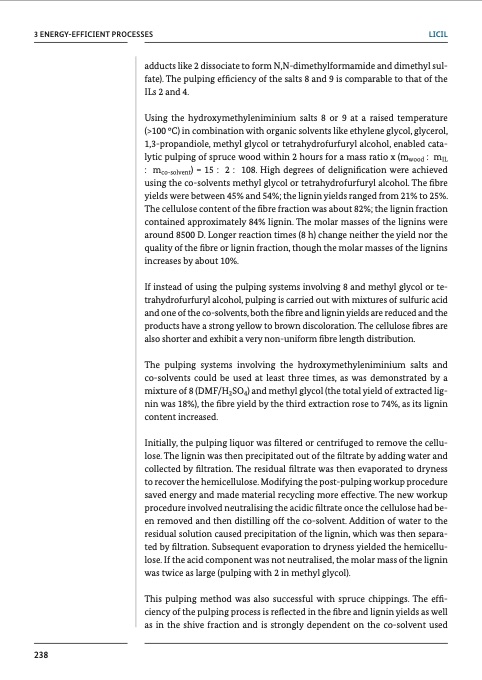
PDF Publication Title:
Text from PDF Page: 241
3 ENERGY-EFFICIENT PROCESSES LICIL adducts like 2 dissociate to form N,N-dimethylformamide and dimethyl sul- fate). The pulping efficiency of the salts 8 and 9 is comparable to that of the ILs 2 and 4. Using the hydroxymethyleniminium salts 8 or 9 at a raised temperature (>100 °C) in combination with organic solvents like ethylene glycol, glycerol, 1,3-propandiole, methyl glycol or tetrahydrofurfuryl alcohol, enabled cata- lytic pulping of spruce wood within 2 hours for a mass ratio x (mwood : mIL : mco-solvent) = 15 : 2 : 108. High degrees of delignification were achieved using the co-solvents methyl glycol or tetrahydrofurfuryl alcohol. The fibre yields were between 45% and 54%; the lignin yields ranged from 21% to 25%. The cellulose content of the fibre fraction was about 82%; the lignin fraction contained approximately 84% lignin. The molar masses of the lignins were around 8500 D. Longer reaction times (8 h) change neither the yield nor the quality of the fibre or lignin fraction, though the molar masses of the lignins increases by about 10%. If instead of using the pulping systems involving 8 and methyl glycol or te- trahydrofurfuryl alcohol, pulping is carried out with mixtures of sulfuric acid and one of the co-solvents, both the fibre and lignin yields are reduced and the products have a strong yellow to brown discoloration. The cellulose fibres are also shorter and exhibit a very non-uniform fibre length distribution. The pulping systems involving the hydroxymethyleniminium salts and co-solvents could be used at least three times, as was demonstrated by a mixture of 8 (DMF/H2SO4) and methyl glycol (the total yield of extracted lig- nin was 18%), the fibre yield by the third extraction rose to 74%, as its lignin content increased. Initially, the pulping liquor was filtered or centrifuged to remove the cellu- lose. The lignin was then precipitated out of the filtrate by adding water and collected by filtration. The residual filtrate was then evaporated to dryness to recover the hemicellulose. Modifying the post-pulping workup procedure saved energy and made material recycling more effective. The new workup procedure involved neutralising the acidic filtrate once the cellulose had be- en removed and then distilling off the co-solvent. Addition of water to the residual solution caused precipitation of the lignin, which was then separa- ted by filtration. Subsequent evaporation to dryness yielded the hemicellu- lose. If the acid component was not neutralised, the molar mass of the lignin was twice as large (pulping with 2 in methyl glycol). This pulping method was also successful with spruce chippings. The effi- ciency of the pulping process is reflected in the fibre and lignin yields as well as in the shive fraction and is strongly dependent on the co-solvent used 238PDF Image | Chemical Processes and Use of CO2

PDF Search Title:
Chemical Processes and Use of CO2Original File Name Searched:
CO2_Buch_engl.pdfDIY PDF Search: Google It | Yahoo | Bing
NFT (Non Fungible Token): Buy our tech, design, development or system NFT and become part of our tech NFT network... More Info
IT XR Project Redstone NFT Available for Sale: NFT for high tech turbine design with one part 3D printed counter-rotating energy turbine. Be part of the future with this NFT. Can be bought and sold but only one design NFT exists. Royalties go to the developer (Infinity) to keep enhancing design and applications... More Info
Infinity Turbine IT XR Project Redstone Design: NFT for sale... NFT for high tech turbine design with one part 3D printed counter-rotating energy turbine. Includes all rights to this turbine design, including license for Fluid Handling Block I and II for the turbine assembly and housing. The NFT includes the blueprints (cad/cam), revenue streams, and all future development of the IT XR Project Redstone... More Info
Infinity Turbine ROT Radial Outflow Turbine 24 Design and Worldwide Rights: NFT for sale... NFT for the ROT 24 energy turbine. Be part of the future with this NFT. This design can be bought and sold but only one design NFT exists. You may manufacture the unit, or get the revenues from its sale from Infinity Turbine. Royalties go to the developer (Infinity) to keep enhancing design and applications... More Info
Infinity Supercritical CO2 10 Liter Extractor Design and Worldwide Rights: The Infinity Supercritical 10L CO2 extractor is for botanical oil extraction, which is rich in terpenes and can produce shelf ready full spectrum oil. With over 5 years of development, this industry leader mature extractor machine has been sold since 2015 and is part of many profitable businesses. The process can also be used for electrowinning, e-waste recycling, and lithium battery recycling, gold mining electronic wastes, precious metals. CO2 can also be used in a reverse fuel cell with nafion to make a gas-to-liquids fuel, such as methanol, ethanol and butanol or ethylene. Supercritical CO2 has also been used for treating nafion to make it more effective catalyst. This NFT is for the purchase of worldwide rights which includes the design. More Info
NFT (Non Fungible Token): Buy our tech, design, development or system NFT and become part of our tech NFT network... More Info
Infinity Turbine Products: Special for this month, any plans are $10,000 for complete Cad/Cam blueprints. License is for one build. Try before you buy a production license. May pay by Bitcoin or other Crypto. Products Page... More Info
| CONTACT TEL: 608-238-6001 Email: greg@infinityturbine.com | RSS | AMP |